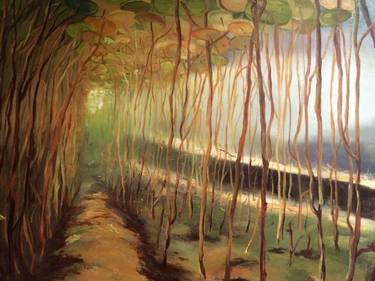- color blindness affects about 10% of the population.
- our role as artists is to share the world how we see it with others so they can see it for themselves.
- The visual brain processes tonal information separately from color information.
- Tonal pathway of thought interprets the where
- Color pathway interprets what.
- specifically moonlight
- Moonlight:
- moonlight is a neutral or reddish colored light
- is so close to the minimum threshold of our color receptors
- why do so many artists paint moonlight with a blue or green tint?
- Do we actually see it that way?
- Edges and Depth:
- Oversharpness in paintings happens because our eyes naturally adjust their focus to both near and far objects
- This can confuse a viewer and should be adjusted so that the painter can emphasize the focus of the painting.
- Adaptation and Contrast:
- shadows or planes are unaffected directly by the light receiving a complimentary contrast to the hue of the light source.
- The Munsell System:
- These colors range in value from black(0) to white(10) and a range of chroma from least to most intense. thus creating a cylindrical shape.
- Grays and Neutrals:
- use grays mixed from the color tint your painting to balance the contrast and harmonize the painting
- Monochromatic Scenes:
- The monochromatic color scheme is composed of any single hue taken through a range of value and chroma.
- Monochromatic paintings often have an antique feel.
:max_bytes(150000):strip_icc()/8231178822_738f0c47cd_o-57c734135f9b5829f46e9338.jpg)
- Warm and Cool:
- Some languages have only two words to describe a color.
- One for Warm colors and one for cool.
- A color can be warm next to a cooler color and cool next to a different warm color.

- Triadic Color schemes and Color Accent:
- These two forms and systems of painting can emphasize specific parts of a painting.
- an artist can choose where they want to lead the eye and how to define the focus point.
- A color accent is any small area of color that is noticeably different from the rest of the colors in the composition.
- can be used for main focus and to unify a piece.
- "A curious, less tense mind makes better choices and observations"
- if that's the case I must be pretty unobservant
- Steps:
- 1. Shape
- 2. color
- 3. foreground
- 4. Details
- 5. Forming shape
- 6. cleaning edges
- 7. Last minute Adjustments
- Sources of Light
- Overcast Light: Colors seem brighter and purer than in direct sunlight.
- Window Light: Light coming through windows is usually bluish.
- Direct Sunlight: Sun,blue sky, and reflected light.
- Candlelight and Fire Light: Yellow-orange in color.
- Indoor electric Light: When painting with incandescent and fluorescent light consider, Relative Brightness, hardness or softness, and color cast.
- Streetlights and Night Conditions: I'm gonna try some night painting




:max_bytes(150000):strip_icc()/8231178822_738f0c47cd_o-57c734135f9b5829f46e9338.jpg)



